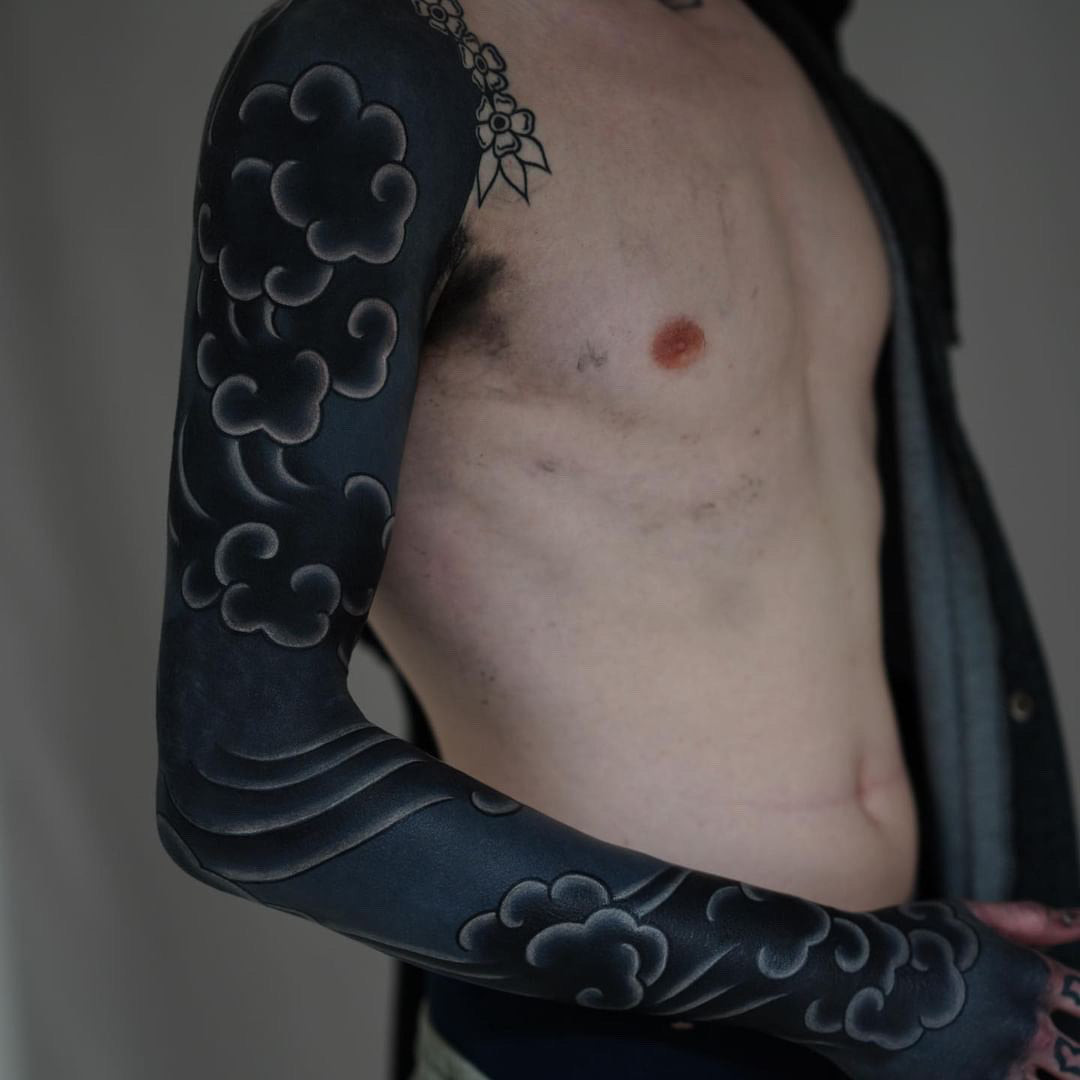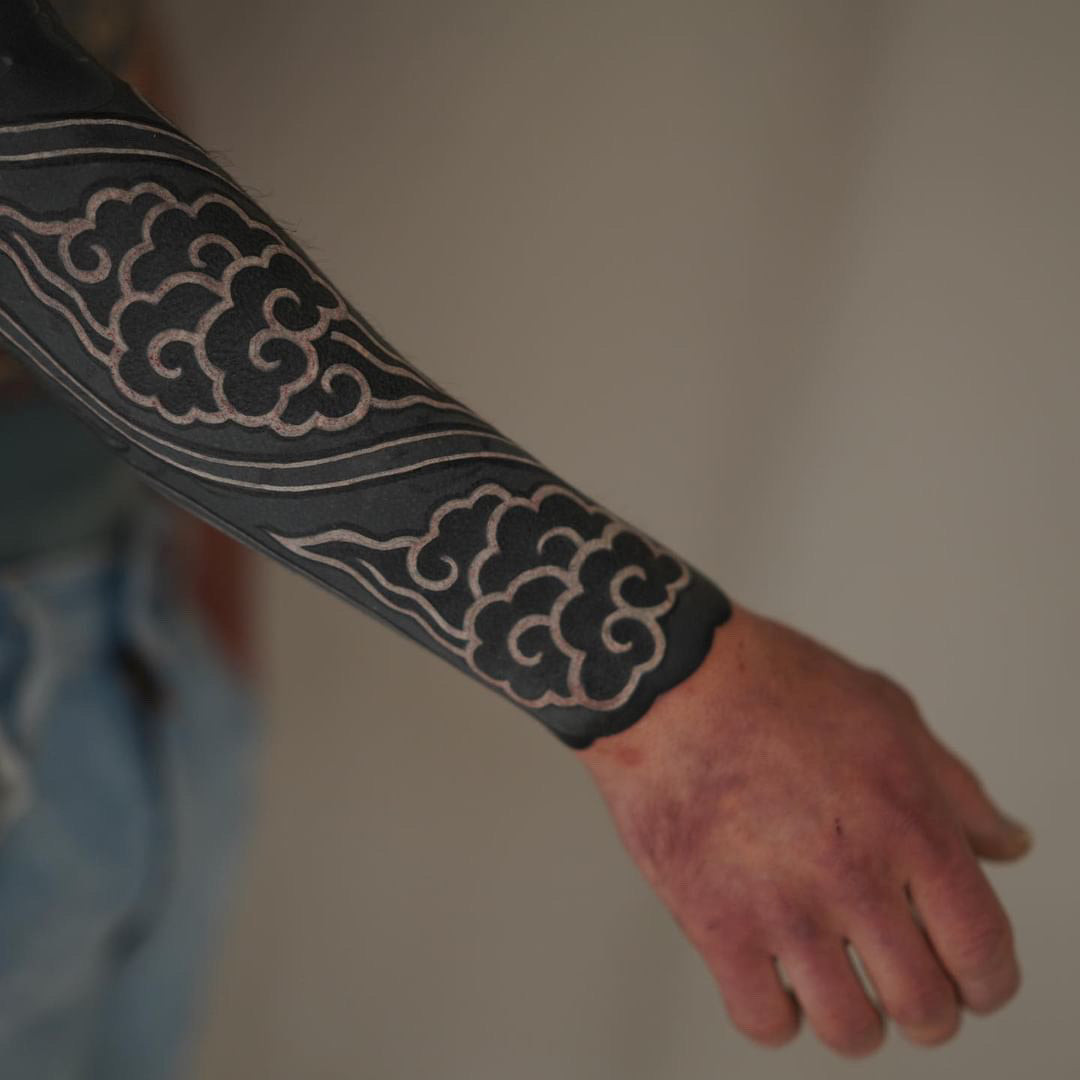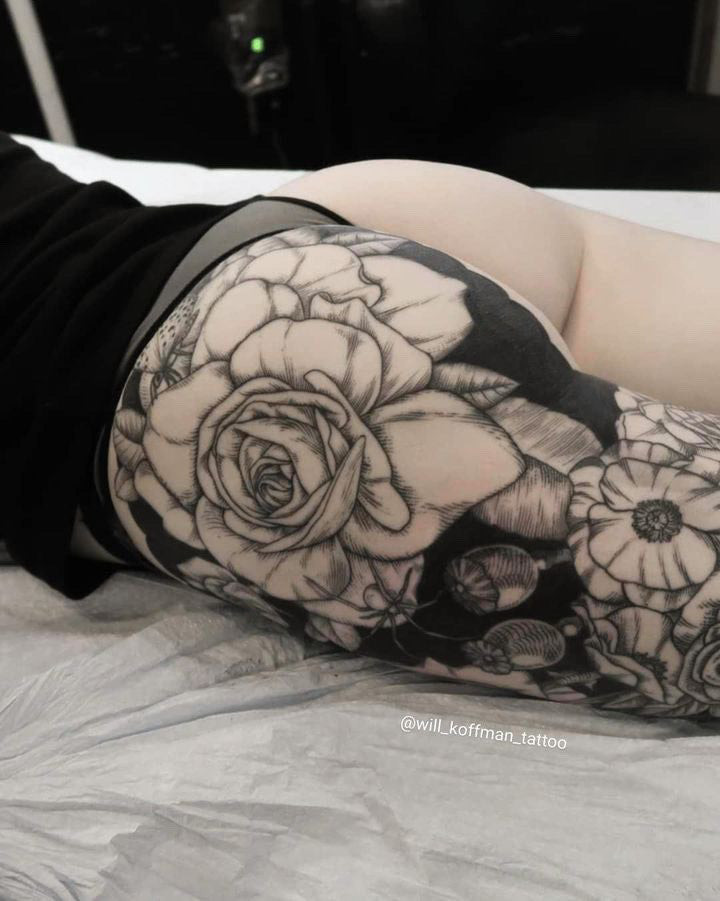White ink over black tattoos is a growing trend in the body art community, but can it truly cover black ink? At tattooat.com, we explore the possibilities, challenges, and artistic potential of using white ink to create stunning designs on top of existing black tattoos, offering expert insights for tattoo enthusiasts and artists alike. Discover the possibilities for cover-up tattoos and learn more about tattoo aftercare.
1. What Exactly is a Blackout Tattoo?
Blackout tattoos involve covering a large area of skin with solid black ink. These tattoos are often chosen for large areas such as the arms or legs, and they offer a bold and striking appearance.
Blackout tattoos are characterized by their complete coverage with opaque black ink, leaving no visible skin patches. The edges of these tattoos often feature distinct shapes, such as geometric forms, abstract waves, or clean, straight lines. According to tattoo artist Will Koffman, blackout tattoos serve not only as aesthetic choices but also as solutions for covering up old or unwanted tattoos. He notes that while originally used primarily for cover-ups, their popularity as a deliberate artistic statement has surged in recent years.
 White ink floral design on a blacked out arm tattoo
White ink floral design on a blacked out arm tattoo
2. Can You Effectively Tattoo White Ink on Top of a Black Tattoo?
Yes, you can tattoo white ink over a black tattoo, but there are factors to consider. Tattoo artist David Handsmark suggests that using white ink over black can be a good alternative, as it can create a fresh canvas for new artwork.
Handsmark highlights that white on black can provide a “start from zero” approach for cover-ups, potentially creating a better and longer-lasting design compared to laser removal. He advises that the specific approach should be tailored to each situation, with the main goal of effectively concealing the original skin with as few sessions as possible while maintaining quality.
There are several techniques for applying white ink over black tattoos. These include:
- Blackout First: Completely blacking out the area before adding white and black ink for design.
- Blastover: Tattooing a new design over an old one and then using white ink to highlight certain areas.
- Blackout Around: Blacking out the skin around existing tattoos to make them stand out.
- Negative Space: Blacking out the area and leaving blank spaces to form the new design.
3. What Makes White Ink a Good Choice for Covering Black Tattoos?
White ink is a solid choice for covering black tattoos because it offers a unique canvas for creating new designs. Tattoo artist David Handsmark emphasizes that it provides a “start from zero” approach, enabling artists to craft better and more durable designs, especially when executed with the correct technique.
According to Inked Magazine, white ink’s opacity, when applied correctly, can effectively lighten or cover darker pigments. This makes it particularly useful in creating contrast and highlights over black tattoos, allowing for intricate details and designs that would not be possible otherwise.
4. Is Getting a White Ink Tattoo Over a Black Tattoo Safe?
The safety of getting white ink over a black tattoo is a valid concern, primarily due to the amount of ink required and the potential ingredients in lower-quality inks. However, according to established tattoo artists, the procedure is generally safe when performed by a professional using high-quality inks.
Will Koffman points out that the market contains some low-quality inks with undesirable materials, but responsible artists avoid these. Ensuring the use of safe, high-quality ink is paramount for minimizing health risks.
According to a study by Portland State University’s Art Department in July 2023, the key to a safe tattoo experience, especially with blackout and white ink combinations, lies in thorough research and selecting a reputable artist. They will use sterilized equipment and inks from trusted suppliers.
5. What Should I Consider Before Getting White Ink Over a Black Tattoo?
Before opting for white ink over a black tattoo, you should consider several factors to ensure satisfaction and safety. Key considerations include commitment, artist selection, pain tolerance, time, and aesthetic expectations.
5.1. Are You Truly Committed?
Blackout and white tattoos are significant commitments, requiring considerable space, time, and financial investment. Will Koffman advises careful consideration, as these tattoos are challenging to remove or cover up completely compared to smaller, simpler designs.
5.2. Have You Chosen Your Tattoo Artist Wisely?
Selecting a specialized artist with experience in white on black tattoos is crucial. David Handsmark recommends researching artists on platforms like Instagram to find someone skilled in this technique.
5.3. What is Your Tolerance for Pain?
The pain level can vary depending on the length of the session, the area being tattooed, and the individual’s pain tolerance. Tattooing over an existing tattoo can also increase discomfort.
5.4. How Much Time Are You Willing to Commit?
These tattoos require multiple sessions to pack in the necessary ink. Will Koffman notes that the process typically spans two to three sessions, as saturating a large area of skin at once can be difficult for the client.
5.5. What Aesthetic Are You Aiming For?
Understand that white ink on black tattoos may not appear as bright as on fresh skin. Will Koffman suggests that bold, graphic artwork tends to hold up better over time, recommending linear drawings in white ink for optimal results.
6. What Aftercare is Needed for a Healed Blackout Tattoo?
Aftercare for a healed blackout tattoo is similar to that of any large color tattoo. Proper aftercare ensures the longevity and vibrancy of your tattoo.
Will Koffman advises that healing a heavy blackout tattoo involves similar care to any large color tattoo. It is common to experience some fatigue or sensitivity in the area for several days following the procedure.
General aftercare steps include:
| Step | Description |
|---|---|
| Follow Artist’s Advice | Adhere to the specific aftercare instructions provided by your tattoo artist. |
| Keep it Clean | Gently wash the tattooed area with mild, fragrance-free soap and warm water. |
| Moisturize | Apply a thin layer of tattoo aftercare cream to keep the skin moisturized. |
| Avoid Sun Exposure | Protect the tattoo from direct sunlight to prevent fading. |
| Stay Hydrated | Drink plenty of water to keep your skin hydrated, which aids in the healing process. |
| Exfoliate | Gently exfoliate the healed skin to help keep the tattoo bright. |
7. Can You Recommend Specific White Ink Designs that Work Well on Black Tattoos?
Certain white ink designs stand out for their effectiveness and visual appeal on black tattoos. These designs often leverage the contrast between the black background and the white ink to create striking and lasting effects.
Here are some popular and recommended white ink designs for black tattoos:
- Geometric Patterns: Geometric shapes and patterns create a visually appealing contrast against the black background.
- Floral Designs: Delicate floral patterns in white ink can add an elegant touch to the boldness of a blackout tattoo.
- Tribal Motifs: White ink tribal designs offer a striking contrast, highlighting the intricate details against the black canvas.
- Abstract Art: Abstract designs allow for creative expression, using the white ink to create unique and eye-catching patterns.
- Dot Work: Fine dot work in white ink can produce stunning gradients and textures, adding depth and dimension to the tattoo.
 White ink ornamental design over a blacked out sleeve tattoo
White ink ornamental design over a blacked out sleeve tattoo
8. How Do Blackout Tattoos Impact the Removal Process if I Change My Mind?
Blackout tattoos can significantly complicate the tattoo removal process due to the density and amount of ink used. The extensive coverage and concentrated pigment make it more challenging and time-consuming to remove compared to traditional tattoos.
Laser tattoo removal works by breaking down the ink particles into smaller pieces that the body can then eliminate. However, black ink absorbs all wavelengths of light, making it more receptive to laser treatment but also requiring more sessions. According to the American Academy of Dermatology, complete removal of a blackout tattoo may not always be possible, and the process can be painful and costly.
Alternatives to laser removal include cover-up tattoos, where a new design is tattooed over the existing one. In the case of a blackout tattoo, this typically involves using lighter inks, such as white, to create a contrasting design. However, the success of a cover-up depends on the skill of the tattoo artist and the design chosen.
9. Are There Any Specific Skin Types That Are More Suitable for White Ink Over Black Tattoos?
While white ink can be used on various skin types, certain skin tones may yield better results. Generally, white ink tends to show up more vibrantly on lighter skin tones compared to darker skin tones.
According to a study published in the Journal of Clinical and Aesthetic Dermatology, the visibility of white ink can vary depending on the individual’s skin pigmentation. Lighter skin allows the white ink to stand out more prominently, while darker skin may require more layers of ink to achieve the desired effect.
However, advancements in tattoo technology and ink formulations have made it possible to achieve satisfactory results on a wider range of skin types. Consulting with an experienced tattoo artist is crucial to assess your skin type and determine the best approach for achieving the desired outcome.
10. How Should I Prepare My Skin Before Getting a Blackout Tattoo With White Ink?
Preparing your skin properly before getting a blackout tattoo with white ink is essential for ensuring the best possible outcome. Proper preparation helps to minimize complications and promotes better healing.
Here are some key steps to prepare your skin:
| Preparation Step | Description |
|---|---|
| Stay Hydrated | Drink plenty of water in the days leading up to your appointment to keep your skin hydrated. |
| Moisturize | Apply a fragrance-free moisturizer to the area regularly to keep the skin soft and supple. |
| Avoid Sun Exposure | Protect the skin from direct sunlight for at least two weeks before your appointment to prevent sunburn or skin damage. |
| Exfoliate Gently | Gently exfoliate the area a few days before your appointment to remove any dead skin cells. |
| Avoid Blood Thinners | Avoid taking blood-thinning medications, such as aspirin or ibuprofen, for at least 24 hours before your appointment. |
| Shave the Area | Shave the area to be tattooed 24 hours before your appointment. |
| Avoid Alcohol and Caffeine | Avoid alcohol and caffeine for at least 24 hours before your appointment, as they can increase bleeding and sensitivity. |
| Get a Good Night’s Sleep | Ensure you get a good night’s sleep before your appointment to help your body cope with the tattooing process. |
| Eat a Healthy Meal | Eat a healthy meal before your appointment to keep your blood sugar levels stable. |
11. What are the Risks Associated with Blackout Tattoos?
While blackout tattoos can be a striking form of body art, it’s important to be aware of the potential risks associated with them. These risks are primarily related to the extensive coverage and amount of ink used in the process.
Some of the common risks include:
- Allergic Reactions: Allergic reactions to tattoo ink can occur, leading to redness, itching, and swelling at the tattoo site.
- Infections: Infections can develop if proper hygiene practices are not followed during or after the tattooing process.
- Scarring: Scarring can occur if the tattoo is not properly cared for or if the skin is overworked during the tattooing process.
- Ink Migration: Ink migration, also known as “blowout,” can occur when the ink spreads beyond the intended area, resulting in blurred lines and a less defined design.
- Difficulty in Removal: Blackout tattoos are notoriously difficult to remove due to the density and amount of ink used.
- Heat Sensitivity: Some individuals may experience increased sensitivity to heat in the tattooed area, especially during prolonged sun exposure.
 Black ink arm tattoo with ornamental white ink details
Black ink arm tattoo with ornamental white ink details
12. How Long Do White Ink Tattoos Last Over Black Ink?
The longevity of white ink tattoos over black ink can vary depending on several factors, including the quality of the ink, the skill of the tattoo artist, and how well the tattoo is cared for. Generally, white ink tends to fade more quickly than other colors, especially when applied over black ink.
According to tattoo artists, white ink tattoos typically last between 5 to 10 years before significant fading occurs. However, this can vary depending on individual skin type, lifestyle, and aftercare practices.
To prolong the life of your white ink tattoo, it’s important to:
- Choose a Reputable Artist: Select an experienced tattoo artist who uses high-quality inks and has a thorough understanding of tattoo placement and aftercare.
- Follow Aftercare Instructions: Adhere to the aftercare instructions provided by your tattoo artist, including keeping the tattoo clean and moisturized.
- Protect from Sun Exposure: Protect the tattoo from direct sunlight by applying sunscreen or wearing protective clothing.
- Avoid Harsh Chemicals: Avoid using harsh chemicals or abrasive cleansers on the tattooed area, as they can cause the ink to fade more quickly.
- Stay Hydrated: Drink plenty of water to keep your skin hydrated, which can help to maintain the vibrancy of the tattoo.
13. What Are Common Misconceptions About White Ink Tattoos?
There are several misconceptions about white ink tattoos that can lead to confusion and unrealistic expectations. Understanding these misconceptions can help you make informed decisions about getting a white ink tattoo.
Here are some common misconceptions about white ink tattoos:
- They Are Invisible: While white ink tattoos are subtler than traditional tattoos, they are not invisible. They are typically visible on lighter skin tones, but may be less noticeable on darker skin tones.
- They Last as Long as Black Ink Tattoos: White ink tends to fade more quickly than black ink, so white ink tattoos typically do not last as long as black ink tattoos.
- They Work on All Skin Tones: White ink may not be as visible on darker skin tones, so it may not be the best choice for individuals with darker complexions.
- They Don’t Require Aftercare: White ink tattoos require the same aftercare as any other tattoo, including keeping the area clean and moisturized.
- They Are Easier to Remove: White ink can actually be more difficult to remove than black ink, as it does not absorb laser light as effectively.
14. How Can I Find a Tattoo Artist Who Specializes in White Ink Over Black Tattoos?
Finding a tattoo artist who specializes in white ink over black tattoos requires careful research and consideration. Not all tattoo artists have the experience and expertise to execute this technique effectively.
Here are some steps you can take to find a qualified artist:
- Online Research: Start by searching online for tattoo artists in your area who specialize in white ink over black tattoos.
- Social Media: Explore social media platforms, such as Instagram and Facebook, to find artists who showcase their work with white ink tattoos.
- Tattoo Conventions: Attend tattoo conventions in your area to meet and network with tattoo artists who specialize in various techniques, including white ink tattoos.
- Ask for Referrals: Ask friends, family, or other tattoo enthusiasts for referrals to reputable artists who specialize in white ink tattoos.
- Check Portfolios: Review the portfolios of potential artists to assess their skill level and experience with white ink tattoos.
- Read Reviews: Read online reviews and testimonials from previous clients to get an idea of the artist’s reputation and customer service.
- Consult with the Artist: Schedule a consultation with the artist to discuss your ideas, ask questions, and assess their understanding of white ink tattoos.
 A tattooed rose design made with white ink over a black arm tattoo
A tattooed rose design made with white ink over a black arm tattoo
15. What Are the Latest Trends in Blackout Tattoos With White Ink?
Blackout tattoos with white ink have evolved into a dynamic and artistic form of body art, with new trends emerging regularly. Staying updated on the latest trends can inspire your next tattoo design.
Here are some of the latest trends in blackout tattoos with white ink:
- Geometric Patterns: Intricate geometric patterns in white ink over black backgrounds are gaining popularity for their visual appeal and precision.
- Floral Designs: Delicate floral designs in white ink add an elegant and feminine touch to the boldness of blackout tattoos.
- Negative Space: Using negative space to create intricate designs within the blackout area is a creative and eye-catching trend.
- Abstract Art: Abstract designs in white ink allow for unique and personalized expressions, adding depth and dimension to blackout tattoos.
- Watercolor Effects: Incorporating watercolor effects with white ink over black tattoos creates a soft and dreamy aesthetic.
- Tribal Motifs: Modern interpretations of tribal motifs in white ink offer a striking contrast against the black canvas.
- Cosmic Themes: Cosmic themes, such as stars, planets, and galaxies, are becoming increasingly popular for their mystical and ethereal appeal.
Ready to explore the world of tattoos? Visit tattooat.com for inspiration, artist connections, and expert advice. Find your perfect design and artist today! Our address is 1825 SW Broadway, Portland, OR 97201, United States, and our phone number is +1 (503) 725-3000.
FAQ: White Ink Over Black Tattoos
- Can white ink completely cover a black tattoo?
While white ink can lighten a black tattoo, complete coverage is difficult. It’s best used for creating designs and highlights.
- How many sessions are needed for white ink over a black tattoo?
Multiple sessions are usually required to achieve the desired effect, as white ink may need to be layered for visibility.
- Does white ink fade faster than black ink?
Yes, white ink tends to fade more quickly than black ink, requiring touch-ups to maintain its vibrancy.
- Is white ink over black tattoos more painful?
The pain level is similar to other tattoos, though tattooing over existing ink can sometimes increase sensitivity.
- What aftercare is needed for white ink over black tattoos?
Follow standard tattoo aftercare: keep it clean, moisturize, and protect it from the sun.
- Can all skin types get white ink over black tattoos?
White ink is most visible on lighter skin tones, but advancements in ink can yield good results on darker skin as well.
- What designs work best with white ink over black tattoos?
Geometric patterns, floral designs, and abstract art often look striking with white ink on a black background.
- Are there risks associated with white ink over black tattoos?
Risks include allergic reactions, infections, and scarring, as with any tattoo. Choosing a reputable artist minimizes these risks.
- How do I find an artist specializing in white ink over black tattoos?
Research online, check portfolios, and ask for referrals to find an artist with experience in this technique.
- What are the latest trends in white ink over black tattoos?
Current trends include geometric patterns, floral designs, negative space, and watercolor effects.
